

AYODHYA

INTRODUCTION
On the right bank of the river Ghaghara or Saryu,as it is called within sacred precincts, stands the holy city of Ayodhya,believed to be the birth place of Lord Rama,the seventh incarnation of Lord Vishnu.Ayodhya is pri-eminently a city of temples. At Ayodhya several religions have grown and prospered simultaneously and also at different periods of time in the past. Remnants of Hinduism,Buddhism,Jainism,Sikhism can still be found in Ayodhya.There is a mention about Ayodhya in Ramayan that the city was founded by Manu, the lawmaker of the Hindus.Ayodhya was initially known as Kosaldesha and w as the ruling dynasty of Ikshvakus of the Suryavansha dynasty.
HISTORY
The ancient city of Ayodhya, according to the Ramayana, was founded by Manu, the law giver of the Hindus. For centuries it was the capital of the descendants of the Surya Vansh of which Lord Rama was the most celebrated king.Ayodhya during ancient time was known as Kosaldesha.The Atharvaveda describes it as a city built by gods and being as prosperous as paradise itself. The illustrious ruling dynasty of this region was the Ikshvakus of the Surya Vansh.The earth is said to have derived its name 'Prthiv'from Prithu, the 6th king of the line. A few generations later came the Mandhatri, in whose line the 31st king was Harishchandra, known widely for his love for truth. Raja Sagar of the same clan performed the Asvamedha Yagna and his great grandson Bhagirath is reputed to have brought Ganga on earth by virtue of his penances. Later in the time came the great Raghu,after whom the family came to be called as 'Raghu Vansh'.His grandson was Raja Dasharatha,the illustrious father of Lord Rama,with whom the glory of the dynasty reached its zenith.
LOCATION
Ayodhya is located in Uttar Pradesh, concentrated more towards the northern region of India. It is situated on the banks of river Saryu in the Faizabad district of Uttar Pradesh.
BEST SEASON
The ideal time to visit this place is during the months of winter.FAIRS AND FESTIVALS
Ram Navami
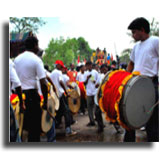 |
Birth of Lord Rama is celebrated on this day and is very popular in Northern India.
During the eight days preceding Ram Navami, Ramayana is read or chanted.
These days are considered very auspicious to do any personal work, celebration or inauguration.
It is celebrated on the 9th day of the bright fortnight of Chaitra month.
Shravan Jhoola Mela
This is celebrated in the month of July/August. As a part of celebration during the festival the deities of Lord Rama, Lakshman and Sita are swung in the temples and then taken to Mani Parvat.
PLACES OF INTEREST
Ramkote
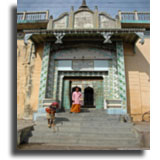 |
The main place of worship in Ayodhya is the site of the ancient citadel of Ramkote, which stands on an elevated ground in the Western part of the city.
Although visited by pilgrims throughout the year, this sacred place attracts devotees from all over India and abroad on Ramnavami, the day of the Lord's birth, which is celebrated with great pomp and show in the Hindu month of Chaitra.
Shri Ramjanma Bhoomi
This believed to be discovered by King Vikramaditya.On the auspicious day of Ramnavami during chaitra month devotees come here in large numbers.
Swargdwar
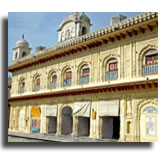 |
The strip of land from Sahasradhara to Nageshwarnath temple is commonly denoted as Swargdwar.
The buildings on the Ghat facing the river were mainly during the reign of Nawab Safdar Jung and his Hindu minister Naval Rai,
who is credited in particular for their construction.
Nageshwarnath Temple
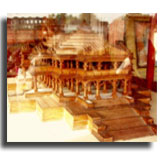 |
Nageshwarnath is considered to be the presiding deity of Ayodhya.
The temple of Nageshwarnath is said to have been established by Khush, the son of Lord Rama.
Legend says that Kush lost his armlet while bathing in the river Saryu, which was picked up by a Nag-kanya who fell in love with him.
The festival of Shivrathri is celebrated here with great pomp and splendour.
Hanumangarhi
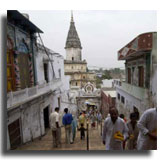 |
Hanumangarhi is one of the most important temples of Ayodhya.
Situated in the centre of the town; the temple is approachable by a flight of 76 steps.
Legend says that Lord Hanuman lived here in a cave and guarded the Ramkote.
Kanak Bhawan
Kanak Bhawan is one of the finest temples in Ayodhya.It was built by queen of Tikamgarh,Vrishbhanu Kuvari in 1891.The main temple is built around an open inner court in which stands a small shrine of Rampada.
Treta Ke Thakur
This temple stands at the place where Lord Rama is said to have performed the Ashvamedha Yajna.About 300 years ago the Raja of Kulu built a new temple here, which was improved by Ahalyabai Holkar of Indore.
Mani Parvat
Stands about 65 feet high and some scholars thinks it to be of Buddhist origin.According to legends it was while Lord Hanuman was carrying the hill bearing the Sanjeevani Booti for Lakshman's wound, from Himalayas on way to Lanka a portion broke off and fell at Ayodhya and this is that very mound.
Guptar Ghat
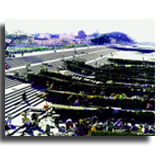 |
On top of the ghats a palace was built which comprises a Sita-Ram temple in the centre of the courtyard.
The shrines of Chakrhari and Guptahari exist here with a small Narasimha temple.
Suraj Kund
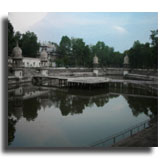 |
Suraj Kund is situated at a distance of 3kms away from Ayodhya which is a large tank with ghats around built by the rulers of Surya Vansh of AYodhya as a homage to the Sun God.
Jain Shrines
There are several jain shrines in and around as it is said to be the birth place of the five Tirthankaras.Kesari Singh,the treasurer of Nawab Faziabad,built five shrines to mark the birth place of these Thirthankaras which bear the date Vikram Samvat 1871.The temple of Adinath is near the Swargdwar,while Anantanath temple stands on the Gola ghat,Sumantnath shrine is at Ramkote,Ajinath temple near Saptsagar while Abinandanath temple is near the Sarai.Anew Jain temple stands in Rai Ganj locality,which houses a unique 21ft.high image of Lord Adinath,the first Tirthankar.
SHOPPING
The shops in and around the temple area mainly consists of souvenirs,photos of temples, shirts with religious prints, devotional objects, idols of Ram and Sita, key chains are some of the items available here.There are also shops which sells brassware, textiles, and zari products.It is a good venture to shop in the bustling town of Ayodhya
EAT OUTS
Ayodhya being a very sacred place there no shops which deal with non vegetarian food for they are not sold in the town.There are many small shops street side shops in the town.One known restaurant here is the Pathik Niwas Saket Guest House restaurant which is very close to the train station.Otherwise the next closeby town where you can get food is Faziabad located at a distance of about 7kms from Ayodhya.
ACCOMMODATION1.Jain Dharamshala
2.Janaki Mahal Trust Dharamshala
3.Kanak Bhawan Dharamshala
4.Niskaam Sewa Aasram
5.Pathik Niwas Saket
6.Abha Hotel
7.Hotel Alka Raje
8.Avantika Hotel
9.Hotel Shane Awadh
10.Tirupati Hotel |
Travel Guide
Travel Information
| |||||||||||||||||||||||||||||||||||||||
GETTING THERE
By Air
The nearest airport are Amausi in Lucknow and Babatpur in Varanasi.
By Rail
Ayodhya is situated on the broad gauge Northern Railway line on Mughal Sarai-Lucknow main route. Ayodhya is connected to various parts of the country like Mumbai, Kolkata, Varanasi and Delhi.

